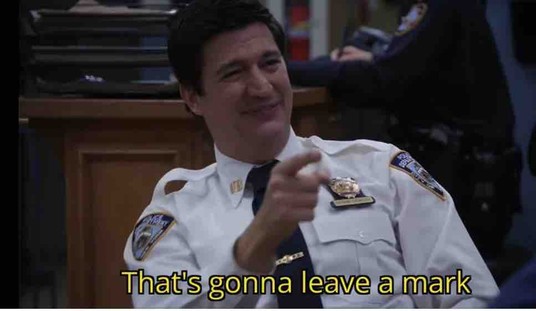Strap yourself in, because this case is actually pretty good. Yep, its time for a patented Aaron WalkerTM Deep Dive!
Regular readers know that San Francisco is a complete and utter mess.
On the other hand, among many lawyers we respect, there is a common belief that the courts can’t do anything about it. They would argue that the only solution is to vote the politicians screwing up their city out. And certainly the residents of San Francisco should try to do that.
But a lawsuit in San Francisco is challenging the belief that the law can’t help solve this problem and their case just cleared a major hurdle. Specifically, they survived a second motion to dismiss on the merits. And the fun thing is it is disabled people leading the way.
We first started hearing about the case, when they won the second motion to dismiss, here:
Huge ruling coming out of San Francisco
— Katie Daviscourt 📸 (@KatieDaviscourt) October 18, 2024
A federal judge has ruled a lawsuit accusing San Francisco of enabling crime and drug use can proceed.
The complaint filed by residents and businesses alleges that San Francisco lawmakers created lawless living conditions by enabling drug… pic.twitter.com/T5NcU4MvZu
The cut off text reads:
The complaint filed by residents and businesses alleges that San Francisco lawmakers created lawless living conditions by enabling drug addicts and dealers to come to the area by providing housing, free drug paraphernalia, and street-based support.
San Francisco allowed drug use and sales in their city-run shelters, and operated a supervised drug consumption lounge where staff distributed drug paraphernalia to addicts, as per the complaint.
The plaintiffs said lawmakers' wonton enablement of drug use cultivated a crime-ridden society that is unlivable.
The city argued that its policies could not be linked to the city's conditions, but US District Judge Jon Tigar shot the city down, allowing the lawsuit to proceed.
The final decision could lay the framework for other progressive cities struggling with the same issues.
The cut off text also contains a link to an article in The Post Millennial and if you want to read the decision on the motion to dismiss, there is a link to that in the article, mistakenly attached to the word ‘complaint.’
For those who are not as well versed in legal procedure, let’s explain the process, briefly. This is a federal lawsuit so it starts with a ‘complaint.’ That is a statement of facts that entitles you to relief, or to put it more simply, you have to explain to the court what facts you hope to prove that shows you should win this case. Very often, the plaintiff will then face a motion to dismiss. A case can be dismissed for many reasons that has nothing to do with the legal merits, such as a lack of jurisdiction, but this one faced a motion to dismiss for failure to state a claim, which is a direct challenge to the merits.
Basically, that kind of motion to dismiss is saying ‘even if all of the facts you allege are true, you still lose.’ That also means outside of very limited exceptions, a defendant in that situation can’t challenge the facts. That can be very surreal to a defendant who thinks one or more of the facts the plaintiff alleges is just a flat out lie, but you have to live within the world of those alleged facts. If you want to challenge the facts, that comes later in the process. But at this point, the court is asking ‘can you tell me a story that adds up to you winning or not?’
But let’s back up for a moment here. Sharp eyed readers might have caught us saying that this was the second motion to dismiss. Well, we have tracked down a copy of the first order dealing with the first motion to dismiss and posted the link online:
Hey guys, I am working on a post talking about a case where residents and businesses are suing San Francisco for the absolute state it is in. You can read the first motion to dismiss, here: https://t.co/W06qegBQ4F
— Aaron's Law (@AaronWalkerLaw) October 23, 2024
Recommended
Basically, the plaintiffs are residents and businesses in San Francisco’s Tenderlion area (geez, now we are hungry), alleging that this area is so badly mismanaged that it violates various residents’ and business’ legal rights, under the (federal and state) Constitution, statutory law and common law.
So, what are the causes of action—or the legal theories for how they can stick it to San Francisco? In both the original order on the motion to dismiss and the second one, the first cause of action that they dealt with was the question of whether or not these peoples’ and business’ (federal) constitutional rights were violated. Since the issue is better developed in the second order on the motion to dismiss, let’s just deal with that one.
The argument involves the Fourteenth Amendment’s Due Process Clause. That reads in relevant part that:
No State shall … deprive any person of life, liberty, or property, without due process of law.
The opinion points out that this typically acts as a negative right, rather than an affirmative right. A negative right is nothing more than a restraint on government. By comparison, an affirmative right is a duty the government has to do something. So, the due process clause operates to prevent the state from such deprivation, rather than giving the state an affirmative duty to protect your life, liberty and property, in most cases. But the opinion points out there are exceptions to this rule of inaction:
The Fourteenth Amendment’s Due Process Clause generally does not confer any affirmative right to governmental aid, even where such aid may be necessary to secure life, liberty, or property interests. … Thus, the Fourteenth Amendment typically does not impose a duty on the state to protect individuals from third parties. There are two exceptions to this rule: (1) when a special relationship exists between the plaintiff and the state (the special-relationship exception); and (2) when the state affirmatively places the plaintiff in danger by acting with deliberate indifference to a known or obvious danger (the state-created danger exception).
(Citations, brackets and quotation marks removed.) The plaintiffs were argued that the government created the danger so the court explained the rule on that:
To succeed on a state-created danger claim, a plaintiff must establish that (1) a state actor’s affirmative actions created or exposed him to an actual or particularized danger [that they] would not otherwise have faced, (2) that the injury they suffered was foreseeable, and (3) that the state actor was deliberately indifferent to the known danger.
(Citation and brackets removed.) Then we get to the damning facts that we know are true:
Plaintiffs here contend that the City’s affirmative acts—operating an illegal drug consumption site, and distributing drug paraphernalia, kits and services to addicts who refuse offers of shelter—created actual and particularized dangers by encouraging ‘gang members dealing drugs and unstable fentanyl addicts to habituate the sidewalks of the Tenderloin.’
(Citations removed.) One point that many people miss is that when we say a state or locality ‘legalizes’ this drug or that drug, that is often very misleading, because there are still federal bans. The most obvious example of that is marijuana. Even possession of marijuana is still illegal under federal law. All a state or local government can do is make it ‘not illegal’ under their laws, but they can’t make it affirmatively legal, because they can’t do anything about federal law.
And frankly, we aren’t just talking about marijuana in this case. We’re just using that example because that is where the ‘myth’ of legality is the most pronounced. Very often the drugs that are being ‘legalized’ in your state is not actually legal in your country (America). And while the federal government might look the other way, there is no guarantee that forbearance will last forever—or, for that matter, that the DOJ won’t decide to selectively enforce the rule against possession against you, perhaps because they don’t like your politics.
In any case, the problem that these plaintiffs run into is that they have to allege a severe injury as a result of the state's actions and typically that refers to bodily injuries, and these plaintiffs said they have been deprived of the use of sidewalk and businesses have been harmed. That isn’t enough in the case law so they lose on that count.
Next, we get to Americans with Disabilities Act and it helps to understand how the ADA works, at least in brief. This author is a disabled lawyer and we have litigated ADA claims ourselves. One thing we have observed over time is that the ADA often can be used to open the door to better treatment for everyone, not just disabled people.
For instance, one of this author’s disabilities is dysgraphia. In our case, it is a disability that makes it hard for us to write by hand. But, crucially, it only effects our ability to write by hand, and not on a keyboard. So, when we started college, we had to be able to use a laptop computer or else we wouldn’t be able to take notes in class. But in 1995 that was unusual and there was some resistance to that among our professors, and this author was the only person in class allowed to do that. But by the time we went to law school, about three quarters of the class were using laptops and it wasn’t even really an accommodation anymore—it was just how everyone was allowed to operate, disabled or not. And frankly, we think that is for the best—everyone should be able to use a laptop in class if they wanted to, at least at the college/university level. And we have to think that it was disabled people who paved the way for that policy.
As you will see in a moment, we think disabled people are able to serve in a similar role, here.
And it helps to understand a bit about how the ADA works. Most of the time, when people talk about the ADA, they think of the reasonable accommodation requirement but the truth is that the heart of the law is the anti-discrimination principle. It basically says ‘don’t discriminate against the disabled.’
As for the reasonable accommodation portion, that originated in Title VII the Civil Rights Act of 1964, dealing with employment. That law is most famous for banning racial discrimination but it also banned discrimination based on religion. Conservatives have been using that provision a lot lately, arguing for instance that discriminating against a conservative based on their political views is also religious discrimination because their politics is shaped by their religion.
Anyway, the people drafting the Civil Rights Act of 1964 recognized that people might try to discriminate against people by religion not openly discrimination against the group directly, but by instituting policies that were neutral on their face, but harmed a particular religious group more than others. For instance, a person who hates Jews might require everyone to work on a Saturday, thus eliminating those religiously Jewish people who observe the sabbath. When a neutral rule clashes with a religious practice, the employer has to provide accommodations where it is reasonable to do so. Thus, if an employer says to a sufficiently observant Jew ‘you’re fired because you won’t work on the sabbath,’ the courts will look at whether or not the Jewish observation of the sabbath could have been reasonably accommodated. If it couldn't, then the firing was illegal discrimination based on faith.
So, when the ADA came around, they had a ready framework for dealing with neutral rules that clashes with a disability that had been in practice for several decades by that time. After all, in a way, many religious practices are almost like ‘voluntary disabilities’ (except many would dispute that their religion is truly voluntary).
Moving back to this specific case, from what we have read about San Francisco over the years, it might be hard for anyone to walk on their sidewalks, disabled or not, with all the homeless people and their belongings strewn about. But the ADA doesn’t protect everyone: Only disabled people can sue under this law. And several disabled people are part of this lawsuit, arguing that the policy in San Francisco of allowing homeless people to be everywhere violates the ADA because these plaintiffs have mobility impairments that make it difficult-to-impossible to navigate the streets. Thus as the title said, disabled people to the rescue! From the first order:
Plaintiffs here allege that the ‘sidewalks and public spaces’ in their neighborhood are impassable and inaccessible to them due to ‘[e]ncampments and bulky items, such as duffle bags, shopping carts, and disassembled bicycles.’
(Citation omitted.) So that was enough to state a claim under the ADA.
You might also see a reference to Section 504 of the Federal Rehabilitation Act (FRA). The best way to understand this law is it was sort of like the ADA before the ADA was passed—it is nearly identical in language—with the major difference being that it was tied to the spending power under the Constitution. The ADA is tied to the power to regulate commerce and to enforce the Fourteenth Amendment. So, with the FRA, they have to prove that the appropriate entities accepted funds and they have alleged enough to satisfy that requirement. They will have to prove the appropriate entities are accepting those funds later as the case goes on, but we are not sure that will be important, because the ADA will already be doing the same work.
The same can also be said about the the California Disabled Persons Act, which the Court calls the ‘DPA.’ This statute was brought up in the second complaint and it can be dealt with pretty quickly. The Court said that if the ADA is triggered, then the DPA is also triggered. So, yeah, more redundancy in this law.
In the first order, the Plaintiffs also complain that this behavior violates part of the California Constitution that provides that
All people are by nature free and independent and have inalienable rights. Among these are enjoying and defending life and liberty, acquiring, possessing, and protecting property, and pursuing and obtaining safety, happiness and privacy.
This language is similar to the Declaration of Independence, except it isn’t as eloquent and the Court in this case said that this doesn’t create an affirmative duty on San Francisco to make their city not be a complete hellhole. So that claim failed.
(That being said, never forget that your state has a Constitution, too. You never know what might be lurking in it. This author can tell you of at least one specific time when we were trying to protect a client and the federal Constitution wasn’t helping us, but the relevant state constitution was more expansive.)
And that would be the last of the claims dealt with in the original order. Thus, if you are keeping track, that would be two constitutional claims—one federal and one state—failing, and then the ADA and a similar law saving their bacon.
As for the second order, we have seen how they lost again on a (federal) constitutional claim and then how a claim based on the California Disabled Persons Act succeeded mainly because in the previous order the ADA claim succeeded. But there was one more claim to deal with in the second order: Nuisance.
Nuisance is a classic common law action. From the order:
Under California law, a nuisance is anything that is injurious to health or is indecent or offensive to the senses, or an obstruction to the free use of property, that interferes with the comfortable enjoyment of life or property, or unlawfully obstructs the free passage or use, in the customary manner, of any navigable lake, or river, bay, stream, canal, or basin, or any public park, square, street, or highway. … Unlike public nuisance, which is an interference with the rights of the community at large, private nuisance is a civil wrong based on disturbance of rights in land. … A nuisance may be both public and private, but to proceed on a private nuisance theory the plaintiff must prove an injury specifically referable to the use and enjoyment of his or her land.
(Citations and quotation marks omitted.) To be blunt, this area of law is more than a little mushy, measuring things such as the reasonableness of the alleged nuisance, how useful the thing creating a nuisance is, and so on. So, while many people would find a person mowing their lawn noisy and maybe even annoying, that isn’t a nuisance in any jurisdiction we are aware of because, well ... you got to cut your grass. On the other hand, if you are playing boom music at three in the morning for weeks on end, that would probably be considered a nuisance.
It also requires either an affirmative act, or a failure to act when there is a duty to do so, but these plaintiffs argue that the city affirmatively created the nuisance:
Specifically, Plaintiffs allege the City has operated a congregate shelter at the COVA where it allows occupants to sell and use narcotics; has operated consumption cites [Aaron: sites?] in the Tenderloin; distributes, funds and facilitates the distribution of drug paraphernalia to addicts who refuse offers of shelter; and provides street-based support to those who reject shelter. … Because Plaintiffs allege affirmative conduct on the part of the City that they contend created or assisted in the creation of the nuisance, they need not allege a duty to act.
(Citations omitted.) They also had to allege that the use of their land was injured and they did, by claiming that entrances to their buildings were blocked and they had to deal with ‘smoky bonfires’ outside plaintiffs’ apartments. Finally, the city claimed that these injuries were not their direct fault, but the Court believed that enough had been alleged to make it ‘substantially’ their fault which is defined as ‘more than negligible or theoretical.’ So, it’s a bit of a mushy standard, but the plaintiffs have alleged enough to get by.
Finally, while the Fourteenth Amendment claims were dismissed in the second order, the judge gave the Plaintiff’s 21 days to file a new complaint that might allege enough to survive a motion to dismiss on that point as well.
Now, you might reasonably say ‘Aaron, you handsome and wise litigator, you man among men, how can you say it was disabled people who saved the day here when the nuisance claim survived? That wasn’t limited to disabled people!’
Well, because if there was no ADA claim, they would almost certainly be facing a motion to dismiss for lack of subject matter jurisdiction. Federal courts can’t take every kind of claim. For instance, an ordinary lawsuit over an auto accident isn’t typically going to be heard in federal court. Instead, there has to be ‘federal subject matter jurisdiction’ and there are two basic kinds that are likely to be invoked in a case like this. The first is called ‘federal question jurisdiction’ and the second is called ‘diversity jurisdiction.’
‘Federal question jurisdiction’ is easy to understand. That is when the claim involves some kind of federal law, either involving the Constitution or some kind of federal law. The second involves ‘diversity of citizenship’ meaning that it involves two people or entities from two different states. That was put in the Constitution because of the fear that when a New Yorker sued a Pennsylvanian in New York court, the New Yorker might have too much of an unfair advantage. So it was believed that a federal court would be a better place to adjudicate their claims in a way that treats residents of both states more fairly.
And obviously we don’t have diversity of citizenship because everyone and every entity in this case is in California. So, their only hope is a federal question. The ADA is easily a federal question. (So is the Fourteenth Amendment claim, but that was dismissed for failure to state a claim.) But the nuisance claim is a creature of state law, so how could that be heard in a federal court?
Well, the short answer is something called ‘supplemental jurisdiction’ which is where if you have state claims sufficiently tied to a federal question, the federal court just decide that state law claim that as well. So, if there was no ADA claim, then the court wouldn’t have jurisdiction over the nuisance claim.
Mind you, if the nuisance claim was dismissed, the plaintiffs could probably refile the claim in state court, but we would consider that a pretty big loss because frankly, our impression is that this judge was being very accommodating to these plaintiffs. It’s hard to pinpoint with anything specific the judge said, but we get the feeling that the judge is very much on their side. And it could be as simple as the judge is sick and tired of what a mess San Francisco is, too, and is more than happy to help these plaintiffs give him the excuse to make them clean at least part of it up. So, we suspect bias, but we ain’t exactly broken up about it.
Incidentally, the Judge, Jon Tigar, was an Obama appointee.
In any case, on to reactions:
@RepJeffries @SenSchumer @GovKathyHochul
— Andrea E (@AAC0519) October 19, 2024
Can New York be sued for allowing Venezuelan gang members to run their criminal operations in our streets?
That might be harder. San Francisco got in trouble because they ran a drug operation and let their sidewalks get obstructed.
Excellent news. Elected officials are absolutely 💯 responsible to the tsunami of crime, homelessness, mental illness and drug addicted people all over the Bay Area
— Just Carmen (@Carmen50) October 18, 2024
This is big. Portlanders should bookmark this
— 𝐄𝐋𝐔𝐂𝐈𝐍𝐀𝐓𝐄 (@elucinate) October 18, 2024
--The city argued that its policies could not be linked to the city's conditions
— Flame Still Lit (@FlameStillLit) October 18, 2024
I'm at a loss on how to even comment about that part.
Legal fault can be different from moral fault. For instance, very often the law says that the police have no duty to protect a person from violence by private citizens. For instance, in Castle Rock v. Gonzales, 545 U.S. 748 (2005), the Supreme Court held that even when a woman had a restraining order issued by a court, the Fourteenth Amendment's due process clause created no duty on the part of the police to protect her three daughters from her husband before he murdered them. But we in the public can and should hold the police accountable when they fail to protect the public.
And we will note that other theories of law have not been entirely exhausted. For instance, if Ms. Gonzales could have alleged that the police would have protected her children but didn’t because of the race, sex or religion of her daughters, we think we would have seen a different outcome.
Hey @AGOWA you're next!
— Paige Norman (American Ama) (@AmericanAmaPN) October 18, 2024
"The complaint filed by residents and businesses alleges that San Francisco lawmakers created lawless living conditions by enabling drug addicts and dealers to come to the area by providing housing, free drug paraphernalia, and street-based support. https://t.co/kkxut88KiG
The city made the case that “its policies could not be linked to the city's conditions”.
— gavin_gee (@gavin_gee) October 18, 2024
Please explain why we have a city government at all then? Remarkable admission https://t.co/IXtoLlAuDe
LFG 🚀. I’m gonna sue the daylights out of these people. https://t.co/s6HIk07ABT
— bettersoma (@bettersoma) October 19, 2024
LFG stands for ‘let’s f——g go,’ but without the censorship.
Who wants to represent me in Olympia? I have reciepts as well as my mental health records. https://t.co/xiYSMlasY5
— Candace Mercer ⚔ FTW (@candiomercer) October 18, 2024
We’re not admitted to practice in that jurisdiction, but maybe an enterprising lawyer could reach out to her…?
Thank you judge. This lawsuit must proceed. https://t.co/H5sIcUMOPM
— JB (@SimmonsBart) October 19, 2024
Biased or not, it’s good to see someone trying.
Finally, we would be remiss if we didn’t point out that part of this problem with the homeless everywhere on the West Coast was created in part by the Ninth Circuit itself, with the Supreme Court only recently overturning their dumb ruling that people had a right to sleep on the streets under the Eighth Amendment. Yes, you read that right, they argued that it was a violation of the Eighth Amendment. We wrote about that decision, including how the Ninth Circuit could reach such an absurd conclusion, here.
In any case, if we represented the City of San Francisco, we would suggest that they offer a settlement that involves cleaning up at least that part of the city. In fact, they can turn it into an agreed-upon court order, known as a consent decree. Then the politicians can clean up the city and when people complain about it, they could say, ‘sorry, we’d love to leave those crackheads all over our sidewalks and to continue to hand out free pipes, but, aw shucks, our hands are tied. We are under a court order. Darn it all to heck.’ Then they can pretend the judge is the bad guy, forcing officials to make their city livable again.
Indeed, maybe other officials could clean up their respective communities citing a fear of being sued? One can dream.
But we will see if those rational impulses prevail. We can certainly hope.
RELATED: The Mask Slips: WATCH as Biden Says, 'We Gotta Lock [Trump] Up'
Wall Street Journal: The Biden Harris Administration Encouraged Sinwar to Keep the Hostages
'Yes, We Klan!' Democrats Use Unintentionally Appropriate Imagery for Halloween Meme
‘Magic Bullets! Part Deux:’ The New York Times Doubles Down
WATCH: CBS News’ 60 Minutes DECEPTIVELY EDITS Kamala's Word Salad Response on Israel

























Join the conversation as a VIP Member